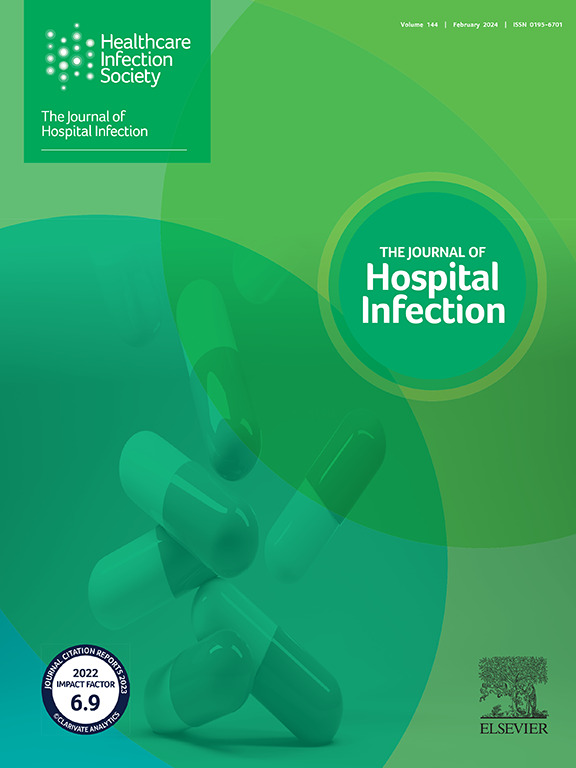乌克兰急诊医院与医疗保健相关的感染和抗菌药物的使用,涉及战争治疗的伤亡:2024年的多中心横断面研究
IF 3.9
3区 医学
Q1 INFECTIOUS DISEASES
引用次数: 0
摘要
背景:乌克兰卫生保健相关感染(HAIs)的真正负担仍然未知。2021年在乌克兰各医院组织了HAIs和抗菌素使用(AMU)的试点流行率调查(PPS),但数据有限,不能完全反映与2022年俄罗斯联邦全面入侵相关的HAIs负担的变化。在乌克兰5个卫生保健机构中进行了关于HAI和AMU的PPS,以了解2024年乌克兰HAI的负担。材料与方法:本研究采用多中心横断面研究。4家三级急症医院和1家专科医院参与了研究。包括来自外科病房、重症监护病房(ICU)和内科病房的所有年龄的患者。每个病房在一天内收集数据,整个研究的时间框架为一个月。HAI病例定义和PPS程序基于最新的欧洲疾病控制中心(ECDC)文件。结果:660例患者纳入研究。83例患者有91例HAI,患病率为12.6%。37例HAI(40.7%)在入院时出现,54例HAI(59.3%)在本次住院期间出现。最常见的HAI是手术部位感染(50.5%),其次是肺炎(12.1%)、皮肤和软组织(9.9%)、尿路(6.6%)、血液(5.5%)和全身感染(5.5%)。icu病房的HAI发生率最高(51.9%),其次是外科病房(12.1%)。最常见的微生物是不动杆菌(22.4%)和克雷伯氏菌(22.4%)。所有HAIs病原菌对第三代头孢菌素、糖肽类和碳青霉烯类均表现出很高的耐药水平(66% -100%)。ICU的抗菌药物使用率最高(88.9%)。结论:该研究发现乌克兰医院的HAI患病率显著高于欧洲平均水平。抗菌药物使用率与欧洲相当,但ICU使用率高得不成比例。本文章由计算机程序翻译,如有差异,请以英文原文为准。
Healthcare-associated infections and antimicrobial use in Ukrainian acute care hospitals involved in treatment of casualties of war: multi-centre cross-sectional study in 2024
Background
The true burden of healthcare-associated infections (HAIs) in Ukraine remains unknown. A pilot point prevalence survey (PPS) of HAIs and antimicrobial use (AMU) was undertaken in Ukrainian hospitals in 2021, but the data are limited and do not represent changes in the burden of HAIs associated with the invasion of the Russian Federation in 2022. As such, in 2024, a PPS on HAI and AMU was conducted in five healthcare facilities to understand the burden of HAIs in Ukraine.
Methods
This research was designed as a multi-centre cross-sectional study. Four acute care tertiary level hospitals and one specialized institution participated in the study. Patients of all ages from surgical wards, intensive care units (ICUs) and medical wards were included. Data were collected on a single day for every ward, and the timeframe for the whole study was 1 month. HAI case definitions and the PPS procedure were based on the most recent documents of the European Centre for Disease Prevention and Control.
Results
In total, 660 patients were included in the study. Eighty-three patients had 91 HAIs, and the prevalence of HAIs was 12.6% point prevalence (pp). Thirty-seven (40.7%) HAIs were present on admission, and 54 (59.3%) were acquired during the current hospitalization. The most common type of HAI was surgical site infection (50.5%), followed by pneumonia (12.1%), skin and soft tissue infection (9.9%), urinary tract infection (6.6%), bloodstream infection (5.5%) and systemic infection (5.5%). The highest prevalence of HAI (51.9% pp) was observed in ICUs, followed by 12.1% pp on surgical wards. The most common organisms were Acinetobacter spp. (22.4%) and Klebsiella spp. (22.4%). All HAI pathogens showed very high resistance (66–100%) to third-generation cephalosporins, glycopeptides and carbapenems. The highest use of antimicrobials was recorded in ICUs (88.9% pp).
Conclusions
This study found a significant prevalence of HAIs in Ukrainian hospitals, higher than the European average. The AMU rate was comparable with the European rate, but with disproportionally higher use in ICUs.
求助全文
通过发布文献求助,成功后即可免费获取论文全文。
去求助
来源期刊

Journal of Hospital Infection
医学-传染病学
CiteScore
12.70
自引率
5.80%
发文量
271
审稿时长
19 days
期刊介绍:
The Journal of Hospital Infection is the editorially independent scientific publication of the Healthcare Infection Society. The aim of the Journal is to publish high quality research and information relating to infection prevention and control that is relevant to an international audience.
The Journal welcomes submissions that relate to all aspects of infection prevention and control in healthcare settings. This includes submissions that:
provide new insight into the epidemiology, surveillance, or prevention and control of healthcare-associated infections and antimicrobial resistance in healthcare settings;
provide new insight into cleaning, disinfection and decontamination;
provide new insight into the design of healthcare premises;
describe novel aspects of outbreaks of infection;
throw light on techniques for effective antimicrobial stewardship;
describe novel techniques (laboratory-based or point of care) for the detection of infection or antimicrobial resistance in the healthcare setting, particularly if these can be used to facilitate infection prevention and control;
improve understanding of the motivations of safe healthcare behaviour, or describe techniques for achieving behavioural and cultural change;
improve understanding of the use of IT systems in infection surveillance and prevention and control.
 求助内容:
求助内容: 应助结果提醒方式:
应助结果提醒方式:


